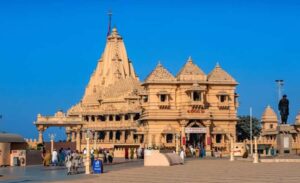History of Gangotri Dham
The sacred town of Gangotri, nestled in the Garhwal Himalayas of Uttarakhand, India, holds immense religious significance in Hinduism. The origin of the Ganges River, one of the holiest rivers in Hinduism, is traced back to the Gangotri Glacier, and the town of Gangotri serves as a crucial pilgrimage site for devotees. The history of Gangotri is intertwined with legends, mythology, and stories that have been passed down through generations, shaping the spiritual fabric of the region.
Legends of Gangotri:
1- The Descent of the Ganges (Bhagirathi’s Penace)
The most prominent legend associated with Gangotri is the descent of the Ganges to the Earth. King Bhagiratha, a descendant of the legendary King Sagara, performed intense penance to cleanse the sins of his ancestors. Pleased with his devotion, Lord Brahma granted him a boon, and Bhagiratha requested the descent of the Ganges to purify the ashes of his forefathers. The river, initially known as Bhagirathi, flowed from Lord Shiva’s locks, who caught it to prevent its force from destroying the Earth. This sacred spot is identified as Gangotri.
2- Lord Shiva’s Role
According to Hindu mythology, Lord Shiva plays a crucial role in the Gangotri legend. It is believed that King Bhagiratha’s penance was so intense that Lord Shiva had to be involved to control the force of the descending Ganges. Lord Shiva, with his matted locks, captured the river, and it is from his hair that the Ganges started flowing, later becoming known as the Bhagirathi.
3- The Reincarnation of Goddess Ganga
Another legend states that the Ganges is not merely a river but the reincarnation of the celestial river goddess Ganga. She descended to Earth in response to the prayers of King Bhagiratha, purifying the land and providing salvation to his ancestors.
Mythological Significance
Gangotri’s mythology extends beyond the descent of the Ganges and involves various mythological figures and deities.
1. The Tapovan Connection
Tapovan, a high-altitude meadow near Gangotri, is believed to be the place where the sages and saints performed rigorous penance. It is said that the great sage Dhyana made Tapovan his abode, and the surrounding region became a sacred center for meditation and spiritual practices.
2. Ganga as a Symbol of Purity
The Ganges, originating from Gangotri, is considered a symbol of purity and divinity in Hinduism. Pilgrims believe that taking a dip in the holy river can cleanse them of sins and facilitate spiritual liberation. The water is also used for religious ceremonies and rituals.
3. The Confluence of Bhagirathi and Alaknanda
Another significant mythological aspect is the confluence of the Bhagirathi River (the Ganges’ source) and the Alaknanda River at Devprayag, forming the Ganges. This confluence is considered highly sacred, and pilgrims often visit Devprayag as part of their Char Dham Yatra.
Historical Significance
1. Early Pilgrimage and Exploration
Gangotri has been a pilgrimage site for centuries, attracting devotees and sages seeking spiritual solace. The town has witnessed the footprints of numerous saints and explorers who ventured into the challenging Himalayan terrain in search of divine connection.
2. Architectural Contributions
The current temple structure at Gangotri is believed to have been built by Amar Singh Thapa, a Gorkha commander, in the early 18th century. The temple, dedicated to Goddess Ganga, stands as a testament to the architectural and religious heritage of the region.
3. Cultural Influence
The cultural influence of Gangotri extends beyond its religious significance. The town and its surroundings have inspired poets, writers, and artists who have depicted the spiritual aura and natural beauty of the region in their works.
Pilgrimage Tradition
1. Char Dham Yatra
Gangotri is an integral part of the Char Dham Yatra, one of the most sacred pilgrimages in Hinduism. The Yatra comprises four holy sites: Yamunotri, Gangotri, Kedarnath, and Badrinath. Pilgrims undertake this journey to attain spiritual merit and seek blessings from the deities.
2. Gangotri Temple
The Gangotri Temple, dedicated to Goddess Ganga, is a vital pilgrimage destination. Situated at an altitude of 3,100 meters, the temple opens its doors to devotees in late April or early May and closes for the winter season in October or November. The temple’s architecture is simple yet elegant, reflecting the religious and cultural heritage of the region.
3. Religious Festivals
Gangotri comes alive during religious festivals, especially during the Gangotri Festival held annually. Pilgrims and locals participate in various rituals, prayers, and cultural events, fostering a sense of unity and devotion.
Environmental Conservation
In recent times, Gangotri has gained attention not only for its religious significance but also for environmental concerns. The Gangotri Glacier, the source of the Ganges, has been receding, raising alarms about the impact of climate change on the Himalayan region. This environmental aspect adds a contemporary layer to the historical and mythological narratives surrounding Gangotri.
Conclusion
Gangotri’s history is a tapestry woven with threads of mythology, legends, and historical events. It stands as a symbol of spiritual purity, cultural richness, and environmental significance. Pilgrims and visitors continue to be drawn to this sacred town, seeking not only religious blessings but also a connection to the rich tapestry of stories that define Gangotri’s place in the cultural and natural heritage of India.
Also Read






